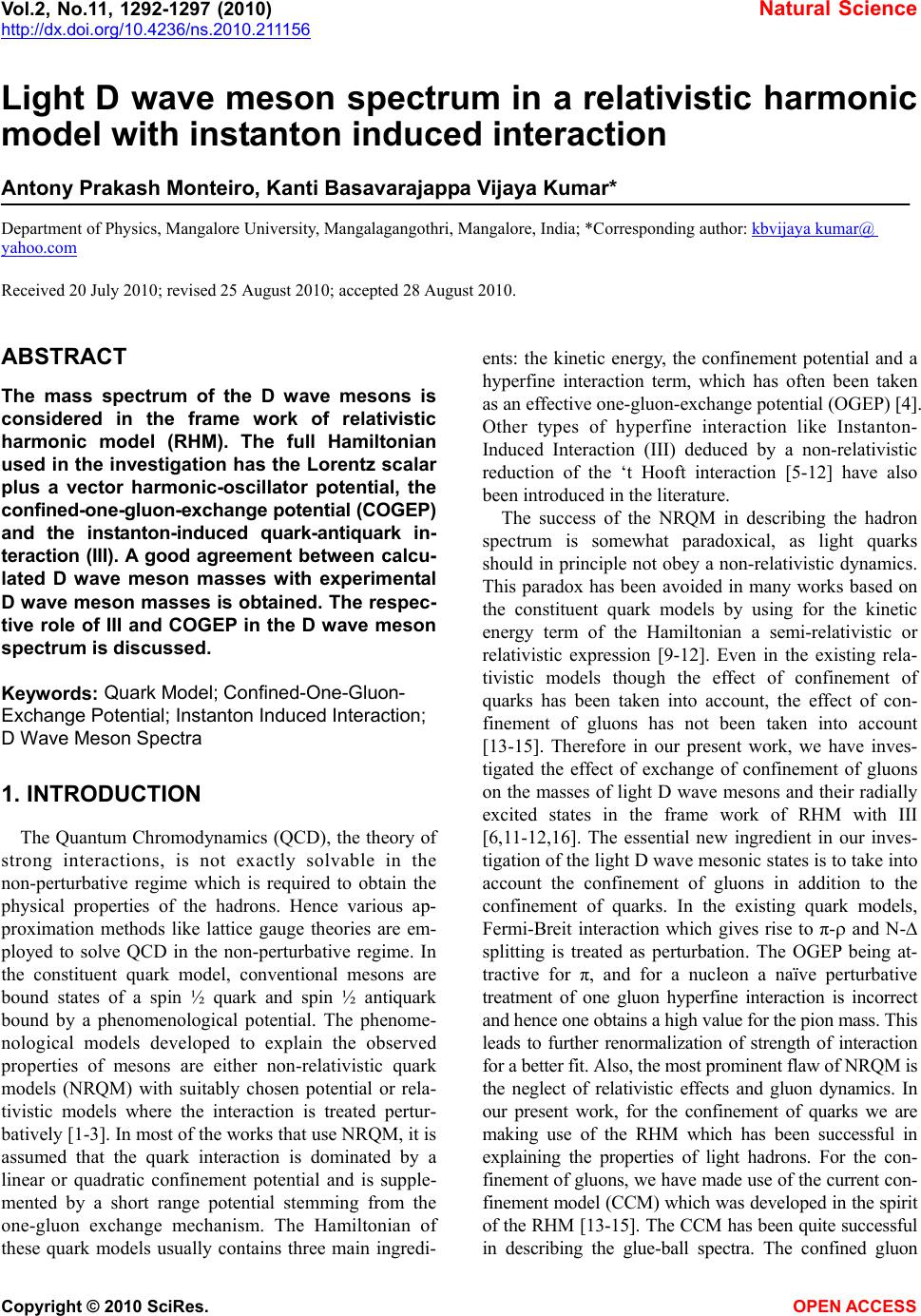
Vol.2, No.11, 1292-1297 (2010) Natural Science
http://dx.doi.org/10.4236/ns.2010.211156
Copyright © 2010 SciRes. OPEN ACCESS
Light D wave meson spectrum in a relativistic harmonic
model with instanton induced interaction
Antony Prakash Monteiro, Kanti Basavarajappa Vijaya Kumar*
Department of Physics, Mangalore University, Mangalagangothri, Mangalore, India; *Corresponding author: kbvijaya kumar@
yahoo.com
Received 20 July 2010; revised 25 August 2010; accepted 28 August 2010.
ABSTRACT
The mass spectrum of the D wave mesons is
considered in the frame work of relativistic
harmonic model (RHM). The full Hamiltonian
used in the investigation has the Lorentz scalar
plus a vector harmonic-oscillator potential, the
confined-one-gluon-exchange potential (COGEP)
and the instanton-induced quark-antiquark in-
teraction (III). A good agreement between calcu-
lated D wave meson masses with experimental
D wave meson masses is obtained. The respec-
tive role of III and COGEP in the D wave meson
spectrum is discussed.
Keywords: Quark Model; Confined-One-Gluon-
Exchange Potential; Instanton Induced Interaction;
D Wave Meson Spectra
1. INTRODUCTION
The Quantum Chromodynamics (QCD), the theory of
strong interactions, is not exactly solvable in the
non-perturbative regime which is required to obtain the
physical properties of the hadrons. Hence various ap-
proximation methods like lattice gauge theories are em-
ployed to solve QCD in the non-perturbative regime. In
the constituent quark model, conventional mesons are
bound states of a spin ½ quark and spin ½ antiquark
bound by a phenomenological potential. The phenome-
nological models developed to explain the observed
properties of mesons are either non-relativistic quark
models (NRQM) with suitably chosen potential or rela-
tivistic models where the interaction is treated pertur-
batively [1-3]. In most of the works that use NRQM, it is
assumed that the quark interaction is dominated by a
linear or quadratic confinement potential and is supple-
mented by a short range potential stemming from the
one-gluon exchange mechanism. The Hamiltonian of
these quark models usually contains three main ingredi-
ents: the kinetic energy, the confinement potential and a
hyperfine interaction term, which has often been taken
as an effective one-gluon-exchange potential (OGEP) [4].
Other types of hyperfine interaction like Instanton-
Induced Interaction (III) deduced by a non-relativistic
reduction of the ‘t Hooft interaction [5-12] have also
been introduced in the literature.
The success of the NRQM in describing the hadron
spectrum is somewhat paradoxical, as light quarks
should in principle not obey a non-relativistic dynamics.
This paradox has been avoided in many works based on
the constituent quark models by using for the kinetic
energy term of the Hamiltonian a semi-relativistic or
relativistic expression [9-12]. Even in the existing rela-
tivistic models though the effect of confinement of
quarks has been taken into account, the effect of con-
finement of gluons has not been taken into account
[13-15]. Therefore in our present work, we have inves-
tigated the effect of exchange of confinement of gluons
on the masses of light D wave mesons and their radially
excited states in the frame work of RHM with III
[6,11-12,16]. The essential new ingredient in our inves-
tigation of the light D wave mesonic states is to take into
account the confinement of gluons in addition to the
confinement of quarks. In the existing quark models,
Fermi-Breit interaction which gives rise to π- and N-
splitting is treated as perturbation. The OGEP being at-
tractive for π, and for a nucleon a naïve perturbative
treatment of one gluon hyperfine interaction is incorrect
and hence one obtains a high value for the pion mass. This
leads to further renormalization of strength of interaction
for a better fit. Also, the most prominent flaw of NRQM is
the neglect of relativistic effects and gluon dynamics. In
our present work, for the confinement of quarks we are
making use of the RHM which has been successful in
explaining the properties of light hadrons. For the con-
finement of gluons, we have made use of the current con-
finement model (CCM) which was developed in the spirit
of the RHM [13-15]. The CCM has been quite successful
in describing the glue-ball spectra. The confined gluon